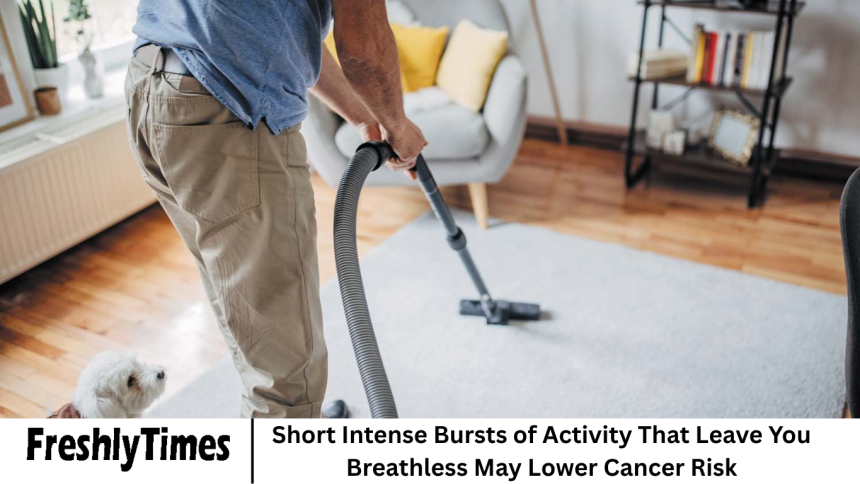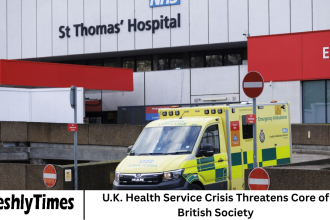In the fast-paced rhythm of modern life, many people struggle to find time for regular exercise. But what if just a few minutes of intense, everyday movement could help protect you against one of the world’s deadliest diseases—cancer?
- Understanding Vigorous Intermittent Lifestyle Physical Activity (VILPA)
- The Groundbreaking Study: How Short Activity Bursts Affect Cancer Risk
- The Science Behind It: Why Intense Activity Protects Against Cancer
- Improved Insulin Sensitivity
- Reduced Inflammation
- Enhanced Immune Function
- Hormonal Balance
- Improved Metabolic Health
- Everyday Activities That Count as VILPA
- How Much Is Enough?
- Who Benefits the Most?
- What Experts Are Saying
- Integrating VILPA into Your Daily Routine
- Potential Limitations and Considerations
- The Broader Implications: A Shift in Public Health Thinking
- Real-Life Success Stories
- Looking Ahead: What Future Research Might Reveal
- Frequently Asked Question
- Conclusion
Recent research suggests that brief, vigorous bursts of physical activity—like running up the stairs, walking briskly to catch a bus, or doing quick chores that make you huff and puff—might significantly reduce the risk of developing cancer.
This article explores what these “short intense bursts” really mean, how they affect the body, the science behind their cancer-fighting power, and how anyone—no matter how busy—can incorporate them into their daily routine.
More Read: Trans Activists Accused of Influencing NHS Study on Gender-Questioning Children
Understanding Vigorous Intermittent Lifestyle Physical Activity (VILPA)
Scientists refer to these brief but intense efforts as Vigorous Intermittent Lifestyle Physical Activity (VILPA). Unlike structured exercise, VILPA doesn’t require gym memberships, equipment, or training plans. It happens naturally in daily life.
For example:
- Running up a flight of stairs instead of taking the elevator.
- Briskly walking uphill or carrying heavy groceries.
- Playing an energetic game with your kids or pets.
- Doing fast-paced cleaning or yard work that raises your heart rate.
Each of these activities may last just 30 seconds to a couple of minutes. Yet when repeated several times a day, they might collectively improve cardiovascular fitness, boost metabolism, and—according to new evidence—reduce the risk of developing cancer.
The Groundbreaking Study: How Short Activity Bursts Affect Cancer Risk
A large-scale study conducted by researchers at the University of Sydney, published in JAMA Oncology, examined how small amounts of vigorous physical activity influenced cancer risk among more than 22,000 adults who did not regularly exercise.
Participants wore wrist accelerometers to track their daily movements for one week. Researchers then followed them for nearly seven years to see who developed cancer. The results were striking:
Individuals who engaged in just 3 to 4 minutes of vigorous physical activity per day—accumulated in short bursts—had up to a 30% lower risk of developing cancer compared to those who did none.
The protective effect was especially strong for cancers linked to physical inactivity, such as breast, colon, and lung cancers.
What’s more, these benefits were observed even in people who never exercised formally. It means that daily tasks that elevate your heart rate and breathing might be enough to lower your cancer risk significantly.
The Science Behind It: Why Intense Activity Protects Against Cancer
So how can such short bursts of movement make such a big difference? The answer lies in how your body reacts to vigorous physical activity on a cellular and hormonal level.
Here’s what happens:
Improved Insulin Sensitivity
Exercise—especially at high intensity—helps the body regulate blood sugar and insulin levels. High insulin and glucose can promote the growth of certain cancer cells. By improving insulin sensitivity, these short bursts help starve cancer cells of their preferred fuel.
Reduced Inflammation
Chronic inflammation is a known driver of cancer development. Vigorous activity stimulates anti-inflammatory responses, lowering levels of harmful cytokines that can lead to tumor growth.
Enhanced Immune Function
Short, intense activity boosts immune system activity, especially natural killer (NK) cells—specialized white blood cells that target and destroy potential cancer cells before they can multiply.
Hormonal Balance
Exercise influences key hormones like estrogen and testosterone, which, when imbalanced, can increase risks of hormone-sensitive cancers such as breast or prostate cancer.
Improved Metabolic Health
Short, high-effort activity helps burn fat and reduce obesity—another major risk factor for several cancers.
In summary, even minimal physical exertion, when intense, can set off a cascade of protective mechanisms in the body.
Everyday Activities That Count as VILPA
The beauty of this approach is that it doesn’t require changing your lifestyle drastically. Most people can easily integrate short bursts of intensity into their daily routine.
Here are examples of activities that count:
- Climbing stairs quickly for 30–60 seconds.
- Power walking or jogging to catch a bus.
- Lifting heavy groceries or carrying boxes briskly.
- Dancing energetically while cleaning or cooking.
- Chasing after kids or pets with enthusiasm.
- Doing yard work like shoveling or raking with effort.
Performing quick bodyweight exercises (squats, push-ups, burpees) during short breaks.
Even short but intense efforts—three or four times a day—can be enough. The key is to raise your heart rate and make yourself breathe faster for a brief period.
How Much Is Enough?
The study’s authors found that just 3 to 4 minutes per day of vigorous activity, spread across several short bouts, provided measurable benefits.
Here’s a simple formula you can follow:
- Target: 3 to 5 minutes of high-effort activity daily.
- Structure: Break it into 30-second to 1-minute bursts.
- Frequency: Aim for at least 3–4 bursts per day.
For instance, taking the stairs twice during the day and doing a 1-minute power clean-up in the evening can already meet the threshold.
This approach works because the body doesn’t differentiate much between short intense bursts and longer workouts, as long as the total exertion stimulates key physiological changes.
Who Benefits the Most?
The study highlighted that even people who were sedentary or overweight benefited significantly from short activity bursts.
Groups that may see the greatest gains include:
- Middle-aged and older adults who find structured exercise difficult.
- Office workers with long sitting hours.
- People with limited mobility or time for gym workouts.
- Those new to exercise or intimidated by traditional fitness routines.
This inclusive approach can help close the gap between the health-conscious and those who’ve struggled to stay active due to lifestyle or physical barriers.
What Experts Are Saying
Dr. Emmanuel Stamatakis, lead author of the University of Sydney study, emphasized that “the beauty of VILPA is that it’s accessible to almost everyone.”
He explained: “Our study shows that even small amounts of vigorous activity embedded into daily life can significantly reduce cancer risk. It’s a message of hope for people who think they’re too busy or unfit to make a difference.”
Cancer organizations worldwide are beginning to acknowledge the growing body of evidence linking lifestyle activity to disease prevention. The World Health Organization (WHO) already recommends at least 75 minutes of vigorous activity per week, but studies like this show that even smaller, fragmented doses may be beneficial.
Integrating VILPA into Your Daily Routine
Here are practical tips for adding these short, high-effort bursts into your day:
At Home
- Race the clock while doing chores—set a timer for one minute and see how much you can clean or organize.
- Do 20 squats or lunges before meals.
- Take the stairs multiple times instead of using elevators.
At Work
- Walk briskly during phone calls.
- Use your break to climb stairs or take a fast-paced walk around the building.
- Park your car further away from the entrance.
Outdoors
- Walk your dog at a faster pace.
- Bike to nearby places instead of driving.
- Carry groceries instead of using a cart when possible.
The goal is not perfection—it’s consistency. Even small efforts compound over time.
Potential Limitations and Considerations
While VILPA shows promising results, it’s not a cure-all or a replacement for comprehensive fitness. Some important notes:
- People with heart conditions or chronic illnesses should consult a doctor before starting intense activities.
- Those aiming for overall fitness or weight loss may still benefit from longer workouts that include strength training and flexibility exercises.
- VILPA’s benefits depend on effort—light activity won’t have the same effect. You need to feel slightly breathless for it to count.
However, for those who are sedentary or time-constrained, it’s an incredibly valuable step toward better health.
The Broader Implications: A Shift in Public Health Thinking
This research could reshape how public health campaigns promote physical activity. For decades, guidelines have emphasized structured exercise routines. But many people find these intimidating or unrealistic.
If further studies confirm these results, governments and healthcare systems might start encouraging people to embrace “exercise snacking”—short, spontaneous activity bursts throughout the day—as a legitimate form of disease prevention.
This shift could have far-reaching effects:
- Reducing cancer rates globally.
- Lowering healthcare costs tied to chronic diseases.
- Making exercise accessible to everyone, regardless of age or fitness level.
Real-Life Success Stories
Early adopters of this concept are already seeing positive results. Take, for instance, office workers who commit to taking the stairs instead of elevators. Many report feeling more energetic, sleeping better, and noticing improved mood within weeks.
Parents playing tag with their kids or individuals incorporating one-minute power walks between meetings often discover these microbursts improve not only physical health but mental clarity and focus too.
These small lifestyle adjustments demonstrate that sustainable change doesn’t require drastic overhauls—just intentional effort.
Looking Ahead: What Future Research Might Reveal
Scientists are continuing to explore how VILPA impacts not only cancer but also other chronic diseases like diabetes, heart disease, and dementia.
Future studies may clarify:
- The optimal number of daily bursts.
- Whether different intensities have varied effects.
- How age, genetics, and diet interact with VILPA benefits.
This ongoing research could help refine public health guidelines and provide even stronger evidence for incorporating short bursts of activity into everyday life.
Frequently Asked Question
What exactly counts as a “short intense burst” of activity?
Any activity lasting 30 seconds to a few minutes that makes you breathe faster and raises your heart rate—like climbing stairs quickly, jogging to catch a bus, or carrying heavy groceries—counts as a short burst.
How much daily activity do I need to reduce cancer risk?
Research shows that just 3 to 4 minutes of vigorous activity per day, accumulated in several short bursts, can lower the risk of developing certain cancers by up to 30%.
Do I need to go to the gym for these benefits?
No. The best part about VILPA is that it happens naturally in daily life. You don’t need a gym, special equipment, or scheduled workouts.
Which types of cancer are most affected by this lifestyle change?
The greatest reductions in risk were seen for cancers related to physical inactivity, including breast, colon, and lung cancers.
Can older adults or beginners safely try this method?
Yes—but start slowly. Even light-to-moderate bursts, like brisk walking or stair climbing, can be beneficial. Those with medical conditions should consult their doctor before beginning.
How is this different from regular exercise?
Traditional exercise involves planned sessions like running or cycling, while VILPA focuses on unstructured, spontaneous activities throughout your day that raise your heart rate for short periods.
Can these short bursts help with other health issues too?
Absolutely. Studies link vigorous short bursts to better heart health, improved metabolism, lower risk of diabetes, and better mental well-being.
Conclusion
The message from this research is empowering: you don’t need a gym membership to protect yourself from cancer. Short, vigorous bursts of activity—climbing stairs, brisk walking, or fast-paced chores—done several times a day can provide a measurable shield against cancer risk.
In a world where time is scarce and sedentary habits dominate, this discovery offers a realistic and hopeful path toward better health. So next time you take the stairs or power-walk across the parking lot, remember: those few breathless moments might be adding years to your life.














